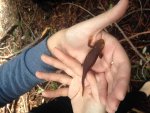sde
Well-known member
Hi all.
Ok, so I know that this has apparently come up in the past, but I could not find the thread, so I am trying to do a new one! So people, young and old, big and small, shy and outgoing, HOW DO YOU TELL THEM APART? It is a question that seems to leave me in curiosity, and I seem to never find a good answer.
I have hear that you can tell from the eyes. If they protrude the head, than its a T. torosa. But my newts have their eyes protruding, and they are NOT T. torosa. I have also heard that that is not a sure way, ( as it would seem from my newts ). I have heard that color size and certain physical characteristics ( i.e. tail longer ) can identify or at least help in identifying. But it personally think that all those can easily be ruled out. I also have heard of their tooth pattern, that T. granulosa have V shaped pattern, but you would be cruel to look on a live individual, so that can only be used on dead individuals. Obviously range is a good indicator, but what about where the ranges overlap? T. torosa are supposed to be more terrestrial, but you may not know how terrestrial the newts in your aria are, you cant monitor them all the time ( well you can with a radio tag, but not many people have those ).
).
So in the end I still have no idea how you can tell them apart without harming them or having a dead specimen.
So is there a way to tell, say on a field trip or something where you just want to know what species it is? A way that doesn't require tooth position determination, DNA samples etc..
So, what do you think?
-Seth
Ok, so I know that this has apparently come up in the past, but I could not find the thread, so I am trying to do a new one! So people, young and old, big and small, shy and outgoing, HOW DO YOU TELL THEM APART? It is a question that seems to leave me in curiosity, and I seem to never find a good answer.
I have hear that you can tell from the eyes. If they protrude the head, than its a T. torosa. But my newts have their eyes protruding, and they are NOT T. torosa. I have also heard that that is not a sure way, ( as it would seem from my newts ). I have heard that color size and certain physical characteristics ( i.e. tail longer ) can identify or at least help in identifying. But it personally think that all those can easily be ruled out. I also have heard of their tooth pattern, that T. granulosa have V shaped pattern, but you would be cruel to look on a live individual, so that can only be used on dead individuals. Obviously range is a good indicator, but what about where the ranges overlap? T. torosa are supposed to be more terrestrial, but you may not know how terrestrial the newts in your aria are, you cant monitor them all the time ( well you can with a radio tag, but not many people have those
So in the end I still have no idea how you can tell them apart without harming them or having a dead specimen.
So is there a way to tell, say on a field trip or something where you just want to know what species it is? A way that doesn't require tooth position determination, DNA samples etc..
So, what do you think?
-Seth


